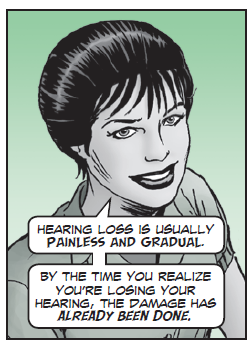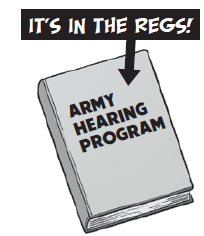BLUF: Your hearing depends on proper protection and, in many settings, it's not optional.
 Photo by Staff Sgt. Jacob Sawyer
Photo by Staff Sgt. Jacob Sawyer
This article initially appeared in PS 776 (Jul 17), pp. 24-26.
Listen up! Your hearing might depend on it. Everyday noise from engines, compressors, jackhammers, shop equipment, power generators and artillery fire injures your hearing over time.
Exposure to certain chemicals called ototoxins (ear poisons), alone or in combination with hazardous noise, can also cause hearing loss. Examples include fuels, pesticides and nerve agents. Activities where noise and ototoxins often combine include painting, fueling vehicles or aircraft, and firing weapons. Get a fact sheet about ototoxins
HERE.
Even if a noise doesn’t seem loud it can harm you, even during training.
 Hearing loss is gradual
Hearing loss is gradual
Hearing loss is gradual. By the time you realize you're losing your hearing, the damage has already been done.
Not only can hearing loss risk your safety, it can put combat communications in jeopardy. Mission safety and effectiveness can be compromised.
 It’s in the regs
It’s in the regs Soldiers and DA civilians
must wear the right hearing protection when working with or around equipment, vehicles, aircraft or weapons that produce hazardous noise levels. For specific noise limits and hearing protector requirements, see Section 7-13 in DA Pam 40-501,
Army Hearing Program, (Jan 15)
HERE.
Soldiers and deployed personnel must wear authorized hearing protectors in combat, particularly when firing weapons, riding in tactical vehicles or in aircraft. Hearing protectors also improve readiness and preserve communications.
Tactical Communications and Protective Systems (TCAPS) are designed to amplify low-volume sounds and help face-to-face and radio communications, while protecting the ears from hazardous impulse noise like weapons fire. Additional info on TCAPS and other operational hearing protection devices can be found in Chapter 6 of DA Pam 40-501.
If you work in a noisy area or your TM directs you to wear hearing protection, you may need earplugs, noise muffs, noise-attenuating helmets, TCAPS or a combination of these. Your installation industrial hygienist, safety officer or preventive medicine representative can test your workplace for dangerous noise levels and recommend appropriate hearing protection.
Hearing Protection Choices
The most common types of hearing protection include triple- or quad-flange preformed earplugs, handformed (foam) earplugs and noise muffs. Active hearing protection devices (HPDs) and other specialized HPDs can be used as well, if appropriate for the listening environment.
Ear canal caps can be used to protect against short or intermittent noise at 95 decibels or less. They’re not as effective in cutting out noise as earplugs or noise muffs.
Handformed (foam) earplugs are disposable, can be used over multiple days if kept clean, and do not require fitting by medically trained personnel. Medical personnel must fit the required preformed triple- or quad-flange earplugs for every servicemember.
Noise muffs are popular due to ease of use. However, to be effective, the headband and earcups must be placed snugly against the head with no gaps. That makes their use impractical in some situations. You can order noise muffs through the federal supply system or from commercial sources.
For a list of approved hearing protection and the NSNs to order them in various sizes, see Tables 7-3 to 7-5 in DA Pam 40-501.
You’ll also find info about the Army Hearing Program (AHP), including hearing testing, protector use and requirements, noise exposure limits and more on the Army Public Health Center website
HERE, including contact information.
Note: Several article links were updated to current URLs.